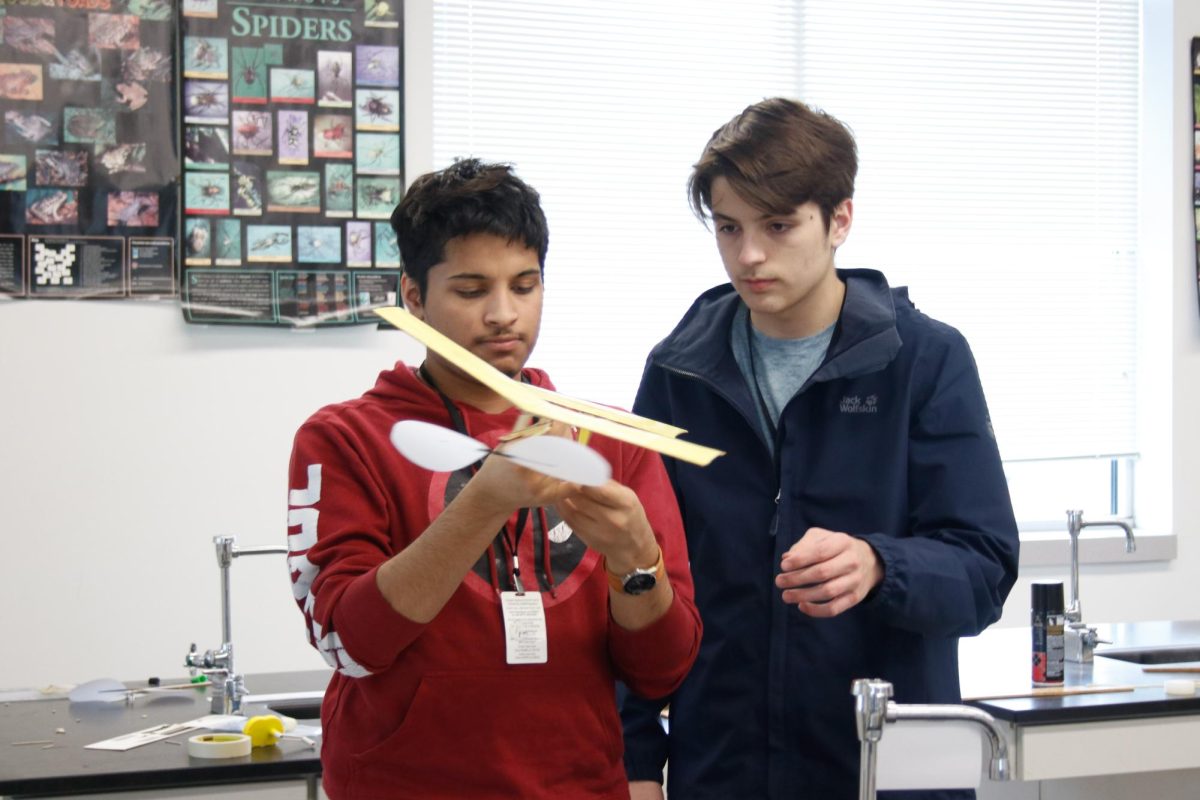The Science Olympiad team is commencing preparations for their competition season, with a lineup of 46 events to plan and prepare before regionals in March.
In two- or three-person teams, varsity and JV will each tackle 23 events. Science Olympiad sponsor and physics teacher Marvin Allen said the organization changes up many of the events annually, either by rotating in old ones or creating new challenges.
Some events require that a project be built prior to competition. Some projects are built on-site. Some events are completely knowledge-based, requiring that the students take a test, and some incorporate both knowledge and building.
Air Trajectory, Wind Power, Robot Tour and Optics are among some of the more exciting fresh-in-rotation or brand-new events this year, according to Mr. Allen. Here’s a glimpse into the minds of the varsity student scientists behind them:
Robot Tour
In this event, senior Thomas Almos and sophomore Kaan Demirer will “design, build, program and test one Robotic Vehicle to navigate a track to reach a target at a set amount of time as accurately and efficiently as possible,” according to the Science Olympiad website.
Thomas is excited to compete in Robot Tour because he finds robots “extremely fascinating.” So far, he and Demirer have ordered parts and will modify the build as they go with additional materials.
“Hopefully [we’ll place] at regionals and state,” Thomas said.
Demirer is hoping to put his experience in robotics to use and build a robot that can “accomplish the tasks given to [them] at the competition.”
“Considering this is a new event, I am nervous on how it will work out,” Demirer said. “But because I did robotics before, I am hoping it will not be too different from what I’ve done.”
Air Trajectory
Prior to the competition, sophomore Daniel Singh and his partner will have to “design, construct, and calibrate a single device capable of launching projectiles onto a target and collect data regarding device parameters and performance,” according to the Science Olympiad website.
“My partner and I have bought the official building kits for the project as of right now and have been finding ways to improve [them],” Singh said.
Singh is looking forward to seeing how the device will run at competition, but he said he worries about complications.
“One thing I am nervous about this event is the amount of things that can go wrong with the machinery and can break,” he said. “One thing we need to accomplish before competition day is to make sure everything works, and [to make sure] we have all our logs with practice runs.”
Wind Power
In Wind Power, senior Will Wojcieszak and his partner will be tested in both their construction abilities and their knowledge of physical science.
“In this event, teams construct a blade assembly device prior to the tournament that is designed to capture wind power and complete a written test on the principles of alternative energy,” the Science Olympiad website explains.
Wojcieszak is more confident in the building aspect of this event than the test.
“The knowledge section for this event will be tough because it is a brand-new event, so my partner and I have nothing to work off of from last year,” he said. “With building, I am very skilled with my hands, and I love to build.”
Though it may present challenges, Wojcieszak said that the event’s novelty doesn’t make him nervous.
“I just really want to win because I am a senior … I am looking forward to having fun and kicking butt,” he said.
Optics
The Science Olympiad website explains that in this event, “teams must participate in an activity involving positioning mirrors to direct a laser beam towards a target and are tested on their knowledge of geometric and physical optics.”
Senior Arik Screnchuk enjoys physical science, and sophomore John Almos likes math, so they were interested in competing in Optics this season.
Mr. Allen ordered John and Screnchuk a kit with materials like they will be provided in the competition, so they could create a game plan. Unlike in Air Trajectory, Wind Power and Robot Tour, competitors in Optics do not get to build their project in advance of their first competition.
“I am excited for the event because I like puzzles and figuring things out on the fly,” John said. “I think this event will do that.”
Screnchuk said the on-site aspect of this event increases its intensity.
“In other events, you hope that the thing you spent months building will work, while in Optics, you have three minutes to finish the build,” he said.
Though they cannot build in advance, John and Screnchuk can prepare for the knowledge portion of the event by studying trigonometry and physics.
“The preparation process … includes practicing trigonometry and geometry problems associated with the alignment of the mirrors to point the laser at a spot on a wall ahead of time,” Screnchuk said.


